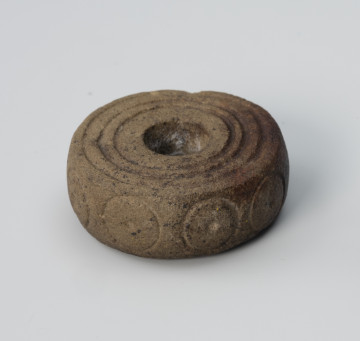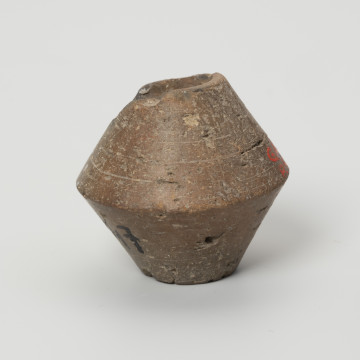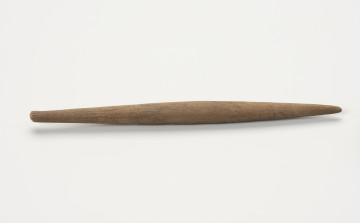
Spindle whorl
900 — 1100
National Museum in Szczecin
Part of the collection: Middle Ages
The presence of numerous whorls in the cultural layers uncovered at early medieval archaeological sites testifies to the prevalence of yarn production as part of everyday household chores. Yarn was made of plant fibres – flax and hemp, as well as from the wool of farm animals, primarily sheep. The cleaned yarn was spun into threads using a wooden spindle loaded with a clay or stone whorl, which was used to keep the spindle vertical during rotation and to prevent the thread from slipping off the spindle during winding. Depending on the type of yarn and the purpose of the thread being produced, yarns of different weights and diameters were used, resulting in a tighter or looser twist. The whorl from Kamień Pomorski is damaged and only half of it survived to this day. The middle section has a hole drilled precisely with an auger, which allowed it to slide onto the spindle. It is made of soft rock – the so-called Volhynian slate. Due to its characteristic pink-red colour, items made from this raw material are considered to be eastern products. Deposits of pink slate have been well studied in the Ovruch region of Ukraine, where the Kamień whorl probably came from. It should be noted that objects from the Volhynian slate in Pomerania are extremely rare and exceptional.
Grzegorz Durdyń
Author / creator
Dimensions
cały obiekt: height: 0.7 cm
Object type
spindle whorl, weaving equipment
Technique
drilling, planing
Material
Volhynian slate, rock
Origin / acquisition method
field research
Creation time / dating
Creation / finding place
Owner
Muzeum Narodowe w Szczecinie
Identification number
Location / status

900 — 1100
National Museum in Szczecin

951 — 1200
National Museum in Szczecin

701 — 1100
National Museum in Szczecin
DISCOVER this TOPIC
Castle Museum in Łańcut
DISCOVER this PATH
Educational path